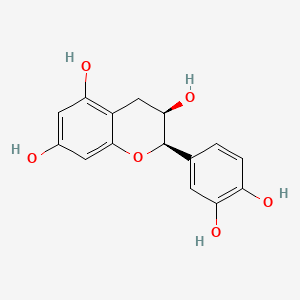| Authors | Title | Published | Journal | PubMed Link |
|---|---|---|---|---|
| Yasuda A et al. | Cacao liquor proanthocyanidins inhibit lung injury induced by diesel exhaust particles. | Int J Immunopathol Pharmacol | pmid:18547470 | |
| Perret C et al. | Fractionation of grape tannins and analysis by matrix-assisted laser desorption/ionisation time-of-flight mass spectrometry. | Phytochem Anal | pmid:12892414 | |
| Seiler N et al. | Synergism between apple procyanidins and lysosomotropic drugs: potential in chemoprevention. | Anticancer Res. | pmid:17094456 | |
| Hao X et al. | Green Tea Polyphenols Inhibit Colorectal Tumorigenesis in Azoxymethane-Treated F344 Rats. | Nutr Cancer | pmid:28323438 | |
| Rizvi SI et al. | Protective role of tea catechins against oxidation-induced damage of type 2 diabetic erythrocytes. | Clin. Exp. Pharmacol. Physiol. | pmid:15730438 | |
| Guendez R et al. | An analytical survey of the polyphenols of seeds of varieties of grape (Vitis vinifera) cultivated in Greece: implications for exploitation as a source of value-added phytochemicals. | Phytochem Anal | pmid:15688951 | |
| Subirade I et al. | Catechin protection of 3T3 Swiss fibroblasts in culture under oxidative stress. | Biol Trace Elem Res | pmid:7779564 | |
| Shen JZ et al. | Green tea catechins evoke a phasic contraction in rat aorta via H2O2-mediated multiple-signalling pathways. | Clin. Exp. Pharmacol. Physiol. | pmid:12542460 | |
| Lv H et al. | Extraction and Separation of Vitisin D, Ampelopsin B and cis-Vitisin A from Iris lactea Pall. var. chinensis (Fisch.) Koidz by Alkaline Extraction-Acid Precipitation and High-Speed Counter-Current Chromatography. | J Chromatogr Sci | pmid:26847919 | |
| Liu R et al. | Mitochondrial DNA-Induced Inflammatory Responses and Lung Injury in Thermal Injury Rat Model: Protective Effect of Epigallocatechin Gallate. | J Burn Care Res | pmid:28198717 | |
| Tang LQ et al. | Effects and mechanisms of catechin for adjuvant arthritis in rats. | Adv Ther | pmid:17660179 | |
| Cyanidanol: will a hepatotrophic drug from Europe go west? | Hepatology | pmid:6822375 | ||
| Oh S et al. | Green tea polyphenol EGCG suppresses Wnt/β-catenin signaling by promoting GSK-3β- and PP2A-independent β-catenin phosphorylation/degradation. | Biofactors | pmid:25352148 | |
| Ikeda S et al. | Effects of a foot bath containing green tea polyphenols on interdigital tinea pedis. | Foot (Edinb) | pmid:23499394 | |
| Kim YJ et al. | New tyrosinase inhibitors, (+)-catechin-aldehyde polycondensates. | Biomacromolecules | pmid:15003008 | |
| Law YL et al. | Influence of catechins on bystander responses in CHO cells induced by alpha-particle irradiation. | Appl Radiat Isot | pmid:19892559 | |
| Korish AA and Arafah MM | Catechin combined with vitamins C and E ameliorates insulin resistance (IR) and atherosclerotic changes in aged rats with chronic renal failure (CRF). | Arch Gerontol Geriatr | pmid:17418908 | |
| Chung JE et al. | Amplification of antioxidant activity of catechin by polycondensation with acetaldehyde. | Biomacromolecules | pmid:14715016 | |
| Subagio A et al. | Simultaneous determination of (+)-catechin and (-)-epicatechin in cacao and its products by high-performance liquid chromatography with electrochemical detection. | Phytochem Anal | pmid:11705334 | |
| Hosnuter M et al. | The Protective Effects of Epigallocatechin Gallate Against Distant Organ Damage After Severe Skin Burns--Experimental Study Using a Rat Model of Thermal Trauma. | Adv Clin Exp Med | pmid:26467128 |
(-)-Epicatechin
(-)-Epicatechin is a lipid of Polyketides (PK) class.
